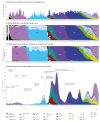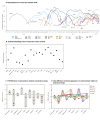Genomic surveillance of SARS-CoV-2 evolution by a centralised pipeline and weekly focused sequencing, Austria, January 2021 to March 2023
- PMID: 38847119
- PMCID: PMC11158012
- DOI: 10.2807/1560-7917.ES.2024.29.23.2300542
Genomic surveillance of SARS-CoV-2 evolution by a centralised pipeline and weekly focused sequencing, Austria, January 2021 to March 2023
Abstract
BackgroundThe COVID-19 pandemic was largely driven by genetic mutations of SARS-CoV-2, leading in some instances to enhanced infectiousness of the virus or its capacity to evade the host immune system. To closely monitor SARS-CoV-2 evolution and resulting variants at genomic-level, an innovative pipeline termed SARSeq was developed in Austria.AimWe discuss technical aspects of the SARSeq pipeline, describe its performance and present noteworthy results it enabled during the pandemic in Austria.MethodsThe SARSeq pipeline was set up as a collaboration between private and public clinical diagnostic laboratories, a public health agency, and an academic institution. Representative SARS-CoV-2 positive specimens from each of the nine Austrian provinces were obtained from SARS-CoV-2 testing laboratories and processed centrally in an academic setting for S-gene sequencing and analysis.ResultsSARS-CoV-2 sequences from up to 2,880 cases weekly resulted in 222,784 characterised case samples in January 2021-March 2023. Consequently, Austria delivered the fourth densest genomic surveillance worldwide in a very resource-efficient manner. While most SARS-CoV-2 variants during the study showed comparable kinetic behaviour in all of Austria, some, like Beta, had a more focused spread. This highlighted multifaceted aspects of local population-level acquired immunity. The nationwide surveillance system enabled reliable nowcasting. Measured early growth kinetics of variants were predictive of later incidence peaks.ConclusionWith low automation, labour, and cost requirements, SARSeq is adaptable to monitor other pathogens and advantageous even for resource-limited countries. This multiplexed genomic surveillance system has potential as a rapid response tool for future emerging threats.
Keywords: Covid-19; NGS; SARS-CoV-2; pandemic preparedness, disease X, genomic surveillance, nowcasting, SARSeq, Austria.
Conflict of interest statement
Figures





References
-
- European Commission. A united front to beat COVID-19. 2021. Available from: https://eur-lex.europa.eu/legal-content/EN/TXT/PDF/?uri=CELEX:52021DC0035
-
- Illumina. Illumina COVIDSeq Test. Available from: https://emea.illumina.com/products/by-type/ivd-products/covidseq.html
-
- Quick J. nCoV-2019 sequencing protocol V.1. Protocols.io. 2020. 10.17504/protocols.io.bbmuik6w 10.17504/protocols.io.bbmuik6w - DOI - DOI
MeSH terms
Supplementary concepts
LinkOut - more resources
Full Text Sources
Medical
Miscellaneous
